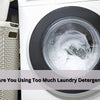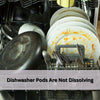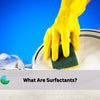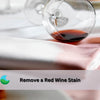The Truth About Laundry Detergents: Keeping Your Family Safe and Your Home Clean
- by Brodie Cook

Doing laundry is a normal part of our lives, but have you ever thought about what's in your detergent? Many common laundry products contain chemicals that can harm our health and the environment. In this article, we'll explore the truth about laundry detergents and learn how to keep our families safe while still keeping our clothes clean.
We'll look at what makes some detergents dangerous, how to choose safer options and tips for using and storing laundry products correctly. By the end, you'll have the knowledge to make better choices for your family's health and your home's cleanliness.
Understanding Laundry Detergent Toxicity

Before the 1950s, people used soap to clean their clothes. This soap was made from natural fats and oils. But during World War II, these ingredients were needed elsewhere. This led to the creation of synthetic detergents made from chemicals. Since then, laundry detergents have become more complex and, unfortunately, more toxic.
Many common laundry detergents now contain harmful ingredients. These include phosphates, bleach, formaldehyde, and synthetic fragrances. These chemicals can cause problems like skin rashes, breathing issues, and even more serious health concerns. Some have been linked to cancer and hormone problems. It's important to know about these risks so we can make safer choices for our families and the environment.
Identifying Harmful Ingredients

When you take a look at a laundry detergent label, you might see words you don't understand. Some of these words could be names of harmful ingredients. Here are some key toxins to watch out for:
- Phosphates: These can cause water pollution and harm fish.
- Formaldehyde: This can irritate your skin and lungs, and might cause cancer.
- Dioxane: This chemical might damage your kidneys and nervous system.
- Bleach: It can burn your skin and cause breathing problems.
- Ammonium compounds: These can hurt your eyes, skin, and lungs.
To read detergent labels, look for a list of ingredients. If you see long, complex chemical names or any of the toxins listed above, it might be a sign of a harmful product. Some brands might use vague terms like "fragrance" or "brightening agents" which can hide toxic ingredients. If a label doesn't list all ingredients or seems unclear, it's often safer to choose a different product. Look for detergents that clearly state they are free from harmful chemicals and use plant-based ingredients instead.
Health and Environmental Impacts
Using toxic laundry detergents can harm both your health and the environment. For your health, these detergents can cause skin problems like rashes and itching. They can also make it hard to breathe, especially for people with asthma or allergies. Some chemicals in detergents might even increase the risk of cancer or mess with your hormones.
These detergents also hurt the environment when they go down the drain. They can end up in rivers and oceans, where they harm fish and other water animals. Phosphates in detergents can cause too much algae to grow, which uses up oxygen in the water and kills fish. Over time, these chemicals build up in the water and soil, making it hard for plants and animals to live there. This damage to nature can last for many years. By choosing safer detergents, we can help keep ourselves healthy and protect the environment around us.
Alternatives to Toxic Laundry Detergents

There are safer options for cleaning your clothes without using toxic detergents. Non-toxic, plant-based detergents are better for your health and the environment. These detergents don't have harsh chemicals, so they're less likely to cause skin problems or breathing issues. They also break down easily in water, which means they don't harm plants and animals.
When looking for eco-friendly detergents that are kinder to environment, check for labels that say "plant-based," "biodegradable," or "free from phosphates and dyes." Look for products with short ingredient lists that you can understand. Some people even make their own laundry soap at home using simple items like soap flakes, washing soda, and borax. This can be a fun and safe way to clean your clothes. Whether you buy eco-friendly detergents or make your own, these choices help keep your family and the planet healthier.
Safe Storage and Handling Practices
Keeping laundry detergents safe at home is very important, especially if you have kids or pets. Always store detergents in a high place or in a locked cabinet where children and pets can't reach them. Keep the products in their original containers with the labels on, so you always know what's inside. After using the detergent, put it away right away.
When you use detergents, follow these safety steps:
- Read the label carefully before you start.
- Don't mix different cleaning products, as this can create dangerous fumes.
- Use only the amount the label suggests.
- Wear gloves to protect your skin.
- If you spill any detergent, clean it up right away and wash your hands.
- Try to do laundry when kids aren't around so you can focus.
- Always close the detergent container tightly after use.
By following these simple rules and the instructions on the label, you can help keep your family safe while doing laundry.
Proper Disposal and Recycling
Getting rid of old detergents and their containers the right way is important for keeping our environment safe. If you have leftover detergent, don't pour it down the drain or throw it in the trash. Instead, check with your local waste management service to find out how to dispose of it safely. They might have special drop-off days for household chemicals.
For empty detergent containers, you can often recycle them. First, rinse the container well to remove any leftover soap. Then, check the bottom of the container for a recycling symbol and number. This tells you what kind of plastic it is. Most detergent bottles are made of recyclable plastic. Remove the cap (you can usually recycle this too) and put the clean, empty container in your recycling bin.
Making the Switch to Safer Options
Changing to safer laundry detergents is easier than you might think. One great option to consider is Lucent Globe Laundry detergent sheets. They're hypoallergenic, biodegradable, and made from plant-based ingredients. Plus, they come in waste-free packaging, which is great for the environment. These detergent sheets clean effectively while being safe for your family and the planet.
FAQs About Laundry Detergent Safety
What makes laundry detergent toxic and potentially harmful?
Laundry detergent can be toxic due to the presence of harmful chemicals such as surfactants, brighteners, and other toxic chemicals that can be harmful to aquatic life and pose health risks to humans.
How can traditional laundry detergent harm the environment?
Traditional laundry detergents contain toxic chemicals that, when washed down the drain, can harm aquatic ecosystems, marine life, and even lead to algal blooms that damage waterways.
Are there non-toxic alternatives to traditional laundry detergents?
Yes, there are non-toxic and laundry detergents available that are harmless to the environment and safer for your family.
Can using toxic laundry detergents lead to skin and respiratory issues?
Yes, exposure to toxic laundry detergents can lead to skin irritations, allergic reactions, dermatitis, and respiratory problems, especially for individuals with sensitive skin.
What are some ways to protect our families and the environment from the dangers of toxic laundry detergents?
To protect your family and the environment, you can opt for non-toxic laundry detergents, use less harmful products, and properly dispose of laundry detergent containers to prevent pollution.

 Dishwashing
Dishwashing Laundry
Laundry Bundles
Bundles Surfaces
Surfaces Toilet
Toilet Handsoap
Handsoap Multi-Purpose
Multi-Purpose Floor
Floor



